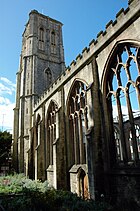Bristol was the fifth most heavily bombed British city of World War II. The presence of Bristol Harbour and the Bristol Aeroplane Company made it a target for bombing by the Nazi German Luftwaffe who were able to trace a course up the River Avon from Avonmouth using reflected moonlight on the waters into the heart of the city.[1]
Between 24 November 1940 and 11 April 1941 there were six major bombing raids. In total Bristol received 548 air raid alerts and 77 air raids with:
- 919 tons of high-explosive bombs and myriad incendiary bombs
- 1299 people killed, 1303 seriously injured, 697 rescued from debris
- 89,080 buildings damaged including 81,830 houses destroyed and over 3000 later demolished.[2]
First raids[]

The ruins of Temple Church
In a night raid on 2 November 1940, 5,000 incendiary and 10,000 high explosive bombs were dropped on the old city.
On 24 November 148 Luftflotte 3 bombers left Germany to bomb Bristol: the attack started at 6.30pm with waves of 2 or 3 bombers passing over Bristol dropping some 12,000 incendiary bombs and 160 tons of high-explosive bombs; within an hour 70 fires had started; Park Street was "smashed"; Bristol Museum hit; 207 people killed and thousands of houses destroyed or damaged.[3] The area that is now Castle Park was extensively damaged. The Jacobean St Peter’s Hospital was destroyed, and the 17th century timber-framed Dutch House was damaged and subsequently demolished. Four of Bristol's ancient churches, St Peter’s, the interior of St Nicholas, St Mary-le-Port and Temple Church were also badly damaged. The St James' Presbyterian Church of England, Bristol was gutted.
The Lord Mayor of Bristol, Alderman Thomas Underwood, described the effect of the raids as "The City of Churches had in one night become the city of ruins."[4]
Following raids[]
On 3 – 4 January 1941 Bristol had its longest raid lasting 12 hours; during this raid the Luftwaffe dropped their biggest bomb on the city. It was nicknamed "Satan", and weighed 2,000 kilograms (4,400 lb), measuring 8 feet (2.4 m) long (without the tail), and 26 inches (66 cm) in diameter; it did not explode. The bomb was recovered in April 1943. The bomb disposal crew had to dig down 29 feet (8.8 m) to get to it. "Satan" was paraded through the streets of London during the VE Day Victory Parade at the end of the war.[5] The infamous Good Friday air raids caused further damage to the centre of the city, Knowle, Hotwells, Cotham and Filton, and caused the permanent closure of the Bristol Tramways. Winston Churchill visited the ruins on 12 April 1941. The last air raid of the Blitz on Bristol was on 25 April 1941, when Brislington, Bedminster and Knowle were bombed. It is speculated that these suburbs were not the targets themselves but that bombs intended for Filton's manufacturing areas were mistakenly dropped on other areas.[4]
One of the common types of bomb dropped on the city was a canister containing a large number of incendiaries (locally known as Goering's Bread Basket – from the Molotov bread basket device); these caused numerous fires and were designed to cause panic amongst the citizens, and stretch the fire services to their limits.[6]
The last raid on Bristol was on 15 May 1944.[7]
Bristol was in danger of being hit by V-1 flying bombs, and by the A4/V2 rockets, whose launching platforms already had been built on the Cotentin peninsula in 1944; D-Day on 6 June 1944 put an end to this danger. The launching platforms on Cotentin were quickly overrun by the allies, so Bristol was safe from the V1 and V2.
Decoys[]
In the early years of World War II there was a sophisticated system of decoy sites all over the country with the aim of diverting air attacks away from the major cities. The main decoy for Bristol was at Black Down on the western end of the Mendip Hills,[8] about 25 km southwest of Bristol. A smaller one was in the parish of Chew Magna. These were known as QL sites, and were designed to simulate Bristol under blackout conditions, even to the extent of mimicking the flickering lights of railway marshalling yards.
In the event of an imminent air raid, beacons were lit at the decoy sites; these were sometimes successful in tricking the Luftwaffe bombers into thinking that it was Bristol, and they dropped their bombs harmlessly onto the hills.
References[]
- ↑ "Overview". Bristol Blitzed. http://www.bristolblitzed.org/?page_id=5. Retrieved 7 March 2007.
- ↑ Blitz over Britain by Edwin Webb and John Duncan 1990, page 90
- ↑ Page 86 Blitz over Britain by Edwin Webb and John Duncan, 1990, ISBN 0-946771-89-8
- ↑ 4.0 4.1 "Bomb Census Bristol: The blitz in Brislington". 24-hour museum. http://www.culture24.org.uk/places+to+go/south+west/bristol/art29320. Retrieved 7 March 2007.
- ↑ http://www.bristolblitzed.org/?page_id=63
- ↑ Richard Harris. "A little Lad's War: Bath Blitz, War Effort, Father Preparing Civil Servants for Germany". WW2 People's War (BBC). http://www.bbc.co.uk/ww2peopleswar/stories/68/a2011168.shtml. Retrieved 3 November 2011.
- ↑ "15 May 1944". Memories of Bristol. Archived from the original on 25 November 2004. http://web.archive.org/20041125092123/weldgen.tripod.com/memories-of-bristol/id2.html. Retrieved 7 March 2007.[dead link]
- ↑ http://www.magic.gov.uk/rsm/33064.pdf
- "WW2 People's War". BBC. http://bbc.co.uk/ww2peopleswar. Retrieved 3 November 2011. – 'WW2 People's War is an online archive of wartime memories contributed by members of the public and gathered by the BBC. The archive can be found at bbc.co.uk/ww2peopleswar'
External links[]
| Wikimedia Commons has media related to Bristol Blitz. |
- Bristol Blitzed
- Bristol Blitz timeline (with photos)
- Bristol Blitz timeline (very detailed timeline, with Avonmouth, Portishead, Weston super Mare, Filton, Yate incl., with technical details a.o.)
- Extracts from the Western Daily press 1940–1944
- Bibliography and Resources: Bristol at War
- Extracts from English Heritage's Record of Scheduled Monuments
- A documentary about the Bristol Blitz and its effect on Castle Park
| |||||||||||
The original article can be found at Bristol Blitz and the edit history here.